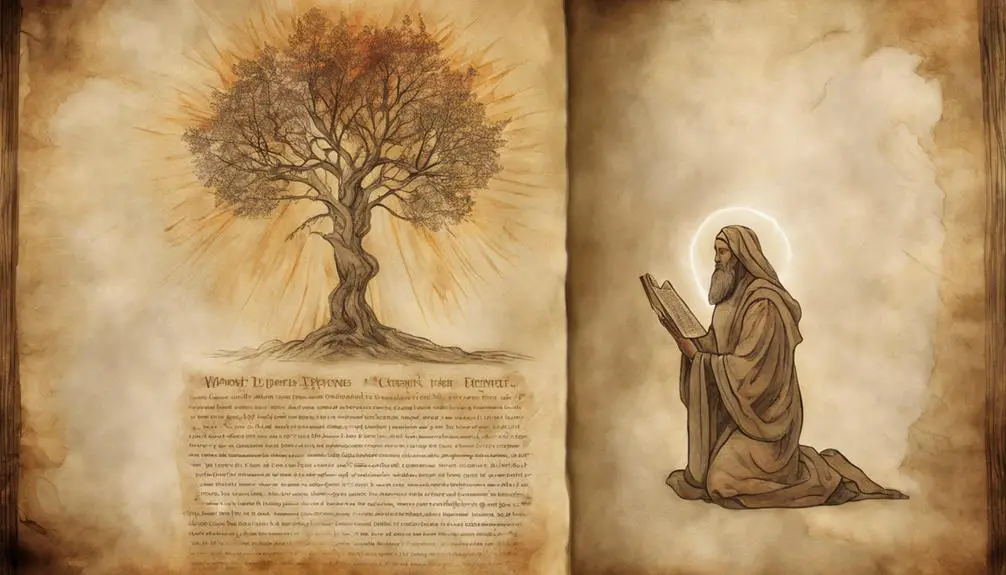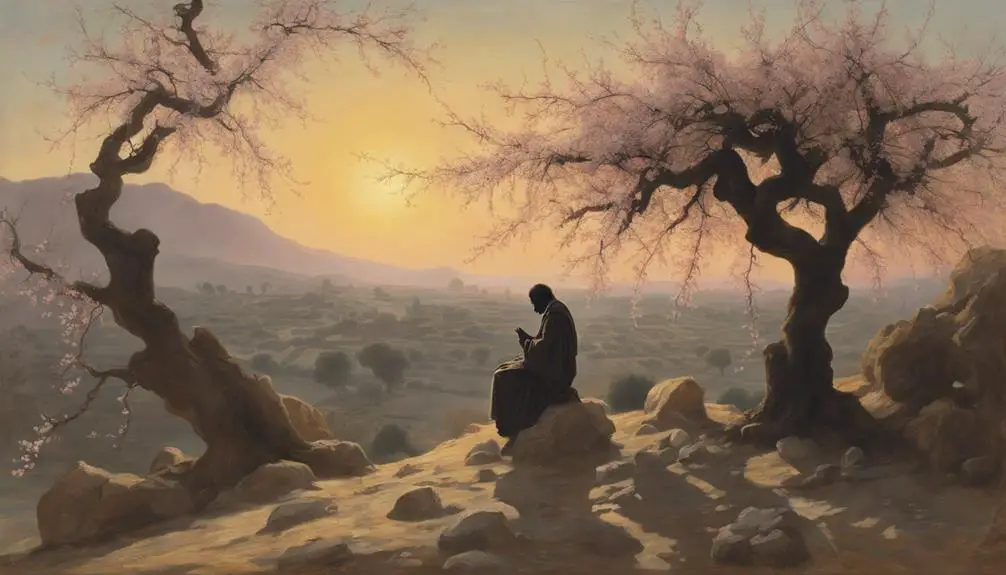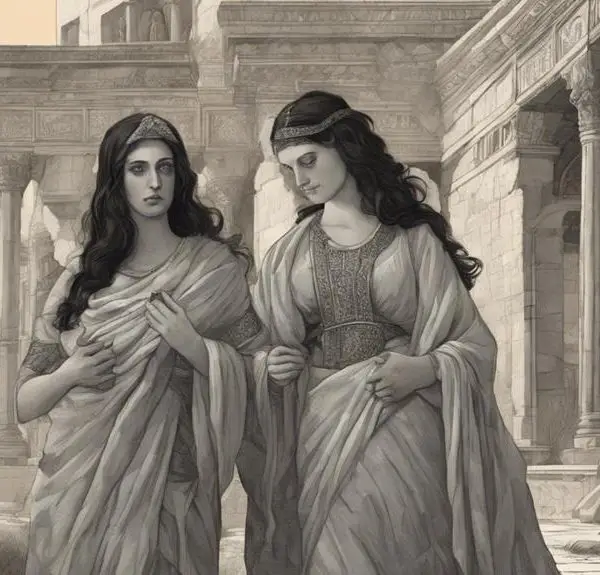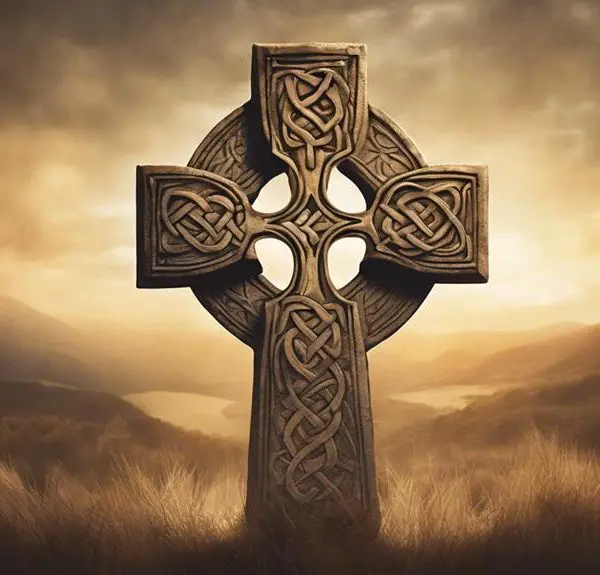Unearth the origins of worship in the Bible, starting with Abel's intriguing sacrifice, and discover what it truly means to revere the divine.

First Time Worship Is Mentioned in the Bible
Like a treasure hunter seeking lost riches, you've embarked on a journey to uncover the origins of worship in the Bible. The first mention, found nestled in the early chapters of Genesis, is steeped in mystery and intrigue.
Here, Abel's sacrificial offering to God opens the door to a compelling exploration of what worship truly means. But what does this episode reveal about our understanding and practice of worship?
Let's dissect the context and implications, and you might just find a goldmine of insights waiting to be unearthed.
Key Takeaways
- The first instance of worship in the Bible is found in Genesis, blending history and theology.
- Genesis establishes the roots of worship in personal devotion and respect, as shown by Abel's sacrifice.
- Genesis' practices influenced the evolution of worship, setting precedents with acts of sacrifice, prayer, and obedience.
- Modern interpretations of worship retain the essence of those found in Genesis while adapting to contemporary demands and technological advancements.
Understanding Biblical Worship

Often, to fully grasp the concept of worship as depicted in the Bible, you must delve into the historical, cultural, and linguistic contexts that shape its interpretation. The evolution of worship practices from the Old to the New Testament provides a rich tapestry of symbolism and spiritual transformation.
Worship symbolism is a critical component of understanding biblical worship. It's often expressed through rituals, objects, or actions signifying deeper spiritual truths. For instance, the burning of incense in the Old Testament symbolized prayers ascending to God. The symbolism embodied in these practices reflects the human desire to connect with the divine in tangible, meaningful ways.
You also need to consider the evolution of worship. Initially, worship was a highly ritualized, communal affair involving sacrifices and strict adherence to the Law. However, it evolved into a more personal, spiritual practice with the advent of Christ. This evolution underscores a shift from external, ritualistic worship to inward, heart-centered devotion.
Genesis: The First Mention

To grasp the primary instance of worship in the Bible, you'll need to turn your attention to the Book of Genesis. This sacred text holds the first mention of worship, nestled within its rich creation narratives. Genesis, in its profound depth, blends history and theology, using symbolic language to illuminate divine truths.
Let's delve into the Genesis symbolism, shall we? The narrative isn't just about physical creation, but it's also an allegory for spiritual beginnings. When God 'rested' on the seventh day, it wasn't due to exhaustion but to set a precedent for mankind. This day of rest or Sabbath, in essence, was an act of worship — a sacred pause, setting aside time to acknowledge and honor the Creator.
Abel's offering in Genesis 4:4 also signifies worship; his sacrifice of the best of his flock signifies reverence and obedience towards God. It's not just the act but the heart behind it that constitutes worship.
In examining Genesis, you'll encounter the roots of worship. It's not merely about rituals or offerings but a deeply personal, intentional act of devotion and respect towards God. By understanding this, you'll gain a new perspective on the nature of worship.
Contextual Analysis of the Passage

Delving into the context of the Genesis passages, you'll discover a complex tapestry of symbolic elements that further illuminate the concept of worship. The cultural influence is clear as Genesis was written in a time when rituals and offerings were significant means of expressing devotion to deities. This setting fosters a richer understanding of the first mention of worship.
The historical significance of this passage is profound. Genesis, being an ancient text, provides a window into the early attitudes towards worship. It's essential to consider the societal norms of the time and their impact on religious practices. The act of worship in Genesis isn't separated from the everyday life of the people but is deeply interwoven. It's a way of life, a commitment, a response to the divine.
The text's language and symbolism also offer insights. The frequent use of the word 'bow', for example, signifies a physical act of respect and submission, intrinsic to the practice of worship. In its entirety, the Genesis passage provides a comprehensive cultural and historical perspective on the concept of worship, enhancing our understanding of its origins and evolution.
Impact on Subsequent Worship Practices

Drawing from the Genesis passages' practices, you'll notice a significant influence on subsequent forms of worship throughout history. The acts of sacrifice, prayer, and obedience depicted in these ancient texts have set a precedence for worship evolution. These early practices laid a foundation for the development of worship rituals not just in the Judaic tradition, but have also had far-reaching influence in Christian and Islamic faiths.
Cultural influences played an extensive role in molding these practices. As societies evolved, so did their understanding and expression of worship. The essence of worship, however, remained consistent: the acknowledgment of a divine power and a humble submission to it.
The impact of these practices is seen in the institutionalization of worship – from the construction of sacred spaces like temples, churches, and mosques, to the establishment of specific rituals and ceremonies. Even the use of music and hymnody in worship can be traced back to these early biblical practices.
However, while the Genesis passages set the early tone of worship, it's important to understand that the evolution of worship practices is a dynamic process, shaped by time, culture, and shifting theological perspectives. Hence, one must view these practices as a starting point rather than a fixed standard.
Modern Interpretation and Application

In the realm of contemporary religious discourse, you'll find that the interpretation and application of these ancient worship practices have taken on new dimensions while still echoing the foundational principles outlined in Genesis. Contemporary Worship Styles, infused with Technological Influences, have transformed the traditional modes of worship into a more dynamic and accessible form.
The table below highlights the transition from traditional to contemporary worship styles:
Traditional Worship Style |
Contemporary Worship Style |
|---|---|
Hymn-based music |
Modern Christian music |
Formal prayers |
Spontaneous prayers |
Physical church spaces |
Virtual platforms |
Print-based scriptures |
Digital scriptures |
Hierarchical leadership |
Collaborative leadership |
In these transformations, you'll observe an attempt to retain the essence of worship while adapting to the demands of the modern world. The application of technology, for example, has not only broadened the reach of worship services but has also enabled a more inclusive and participatory form of worship.
Frequently Asked Questions
What Are Some Other Significant Instances of Worship Mentioned in the Bible?
You'll find numerous significant instances of worship in the Bible. Take King David's dance before the Ark of the Covenant, a profound display of worship.
The Last Supper, too, is a pivotal worship ritual where Jesus establishes the Eucharist.
Additionally, the Wise Men's adoration of Baby Jesus, offering gifts of gold, frankincense, and myrrh, signifies worship.
Each event involves biblical objects and rituals that demonstrate the depth and diversity of worship traditions.
How Does the Concept of Worship Evolve Throughout the Old and New Testaments?
You'll notice that worship rituals and their purpose evolve significantly in the Bible. In the Old Testament, the focus is largely on physical sacrifices and strict adherence to laws.
However, the New Testament shifts towards a spiritual form of worship, emphasizing faith, love, and inner purity over rituals.
It's a progression from external acts to internal devotion, showing a deepening understanding of what it means to truly worship God.
Are There Any Notable Differences in How Worship Is Depicted in Different Translations of the Bible?
Yes, you'll find translation variations in how worship is depicted in different Bible versions.
These differences often arise from cultural interpretations and linguistic nuances. For instance, some translations might emphasize the physical act of bowing or kneeling, while others focus more on the spiritual aspect of devotion.
You'd need to analyze the specific wording used in each translation to fully grasp these differences. Remember, context plays a critical role in understanding these variations.
How Does Worship in the Bible Compare to Worship Practices in Other Religious Texts?
In your comparative worship analysis, you'll find that Bible worship practices often differ from those in other religious texts. Cultural influence on worship plays a significant role, shaping rituals, prayers, and offerings.
While the Bible emphasizes a personal, heartfelt connection to God, other texts may stress communal or ritualistic aspects more heavily. It's crucial to consider each text's historical and cultural context to truly understand its unique representation of worship.
How Have Historical Events Influenced the Modern Interpretation of Worship as Mentioned in the Bible?
Historical events have significantly shaped your understanding of biblical worship.
You'll notice that shifts in cultural context often led to changes in worship symbolism.
For instance, the Protestant Reformation challenged traditional Catholic practices, leading to more personal, scripture-focused forms of worship.
It's fascinating to see how historical experiences have influenced modern interpretations of worship, often making it more relatable to contemporary audiences.
Conclusion
In conclusion, you've seen that the first mention of worship in Genesis sets a crucial foundation for worship practices. It emphasizes the importance of faithfulness and obedience to God, a theme that resonates throughout the Bible.
As you apply this understanding to modern worship, remember that these values remain central. The essence of worship, as first introduced in Genesis, continues to guide our expressions of reverence and love for God today.



Sign up